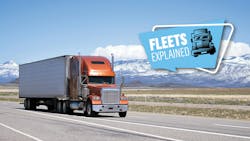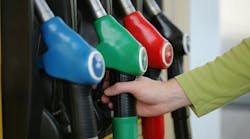Fleets Explained: What actually affects fuel efficiency?
Increased fuel efficiency is something OEMs and fleets are always chasing. Manufacturers have spent millions of dollars in research to improve fuel efficiency, and so has the federal government. The hundreds of millions of dollars spent on the Department of Energy’s SuperTruck initiatives alone are enough to showcase the industry’s focus on increasing fuel economy.
One might think amounts of money this large would be enough to solve the fuel efficiency problem, but as it turns out, multiple factors affect fuel efficiency, and what might work in theory faces a plethora of challenges in reality.
This Fleets Explained entry tackles some of the factors that impact fuel efficiency.
What are you driving?
This is part of FleetOwner's Fleets Explained, a Trucking 101 series to break down aspects of the trucking and fleet management industries. You can read more from the series, launched in May 2024, at fleetowner.com/fleets-explained. To submit topic ideas, clarifications, and corrections, email [email protected].
Are you hauling a packed 53-ft. trailer? Are you in a straight truck? Do you drive a car hauler? Are you zipping across town in a medium-duty cabover? Or are you driving a diesel pickup from job site to job site? Each of these vehicles offers a different average mpg than the next because of their different sizes (both their engines and the vehicles themselves) and because each is spec’d quite differently (not to mention their duty cycle, but we’ll get to that).
A semi-truck weighing from 30,000 to 100,000 lb. averages nearly 7 mpg, according to the American Transportation Research Institute’s Analysis of the Operational Costs of Trucking: 2024 Update. A dump truck averages 5 to 6 mpg, per Dump Truck Dispatcher. Medium-duty trucks, such as a box truck, might get around 13 mpg, according to Penske. Of course, light-duty trucks and vans will offer the highest miles per gallon, with gasoline cargo vans averaging from 12 to 24 mpg, according to Enterprise, and a diesel-powered pickup, like the Silverado 1500, offers 30 mpg or more.
Next, what’s under the hood?
With light-duty vehicles, the addition of turbochargers, such as the 2.7L EcoBoost in some Ford F-150 models, can offer up to 24 mpg on the highway.
Fuel efficiency is also impacted by what transmission is paired with the engine, as the transmission is responsible for the engine’s RPMs—and running at low RPMs increases fuel efficiency.
International touts that its S13 Integrated powertrain leads the trucking industry’s aero category in fuel economy by 5%. This coupling consists of the engine, transmission, and aftertreatment system that work together to offer increased efficiency and profitability, International states.
Mack Trucks also integrates its powertrain—engine, transmission, and rear axles—to increase not only fuel efficiency, but component communication and uptime. Integrating Mack’s MP8 445HE Turbo Compound engine, mDRIVE transmission, and Mack drive axle is “an example of how an integrated powertrain solution maximizes fuel efficiency for highway applications while maintaining the power needed for fully loaded operations,” Joseph Scarnecchia, Mack powertrain sales development manager, previously told FleetOwner.
Worth noting, while manual transmissions are being phased out of the market throughout all vehicle classes, they tend to be more fuel efficient than automatic transmissions, according to the Advanced Transmission Center.
Next, the type of trailer or equipment you’re hauling affects fuel efficiency.
Heavy-duty applications vary significantly because of their loads. A car hauler will get different fuel efficiency than a 53-ft. box trailer, just as a bulk tank trailer will differ in fuel efficiency compared to a flatbed trailer hauling a large piece of equipment.
The same goes for medium-duty vehicles with box trailers, flat beds, reefers, etc.
Likewise, a light-duty pickup with a few tools and equipment in its bed will differ in mileage compared to one that’s also hauling a trailer.
And the final way that what you’re driving influences fuel is through the total vehicle weight and the weight of what it’s hauling. Each pound affects fuel efficiency. Every 100 lb. added to a vehicle could potentially reduce mpg by 2%, according to DOE (though it’s worth noting that 100 extra pounds will affect a smaller vehicle more than a larger one). This is one of the reasons OEMs have shifted to lighter materials and weight-saving innovations.
Even the body weight of the driver and passengers affects fuel consumption.
How are you driving?
While what you’re driving affects fuel efficiency most significantly, how you’re driving also has an impact.
A driver’s behaviors can impact fuel efficiency by up to 12%, according to data captured by TruckWings and noted in a previous FleetOwner article.
Driver behaviors—such as speeding, accelerating, frequent and aggressive lane changes, and harsh braking—have significant impacts on fuel economy. These behaviors require a vehicle’s engine to work harder, which burns fuel unnecessarily.
Speeding affects fuel efficiency due to wind resistance, according to telematics provider GPS TrackIt. The higher the speed, the more resistance a vehicle will experience. Oak Ridge National Laboratory found that fuel mileage is reduced by 7% for every 5 mph a vehicle travels over 50 mph.
While driving at high speeds has its disadvantages, so does accelerating—especially when accelerating from a complete stop. Accelerating from stop is the most inefficient driving cycle for the engine, via GPS TrackIt, as it requires “the most effort to move a heavy object from a standstill with no help from momentum.”
Each engine has its sweet spot where it produces “the most power for the least RPMs,” GPS TrackIt states. Accelerating patiently allows the engine to remain in this sweet spot a bit longer, ensuring maximum fuel efficiency during acceleration.
Harsh braking, also known as late braking, is another behavior that affects fuel efficiency. Once the engine outputs power to get the vehicle moving, a harsh brake essentially wastes it, preventing the vehicle from using the power that was generated and adding unnecessary wear and tear on brake pads and brake systems.
Idling is another driver behavior that affects fuel efficiency. In summer 2023, “large truck operators in the Pacific Northwest spent an additional $1 million on fuel during an August heat wave,” telematics provider Samsara estimated and FleetOwner reported, “assuming a cost of $4 per gallon and 0.85 gallons of fuel was used per hour of idling.”
While it can’t always be avoided, idling can be mitigated by encouraging drivers to lower their windows on pleasant days instead of using HVAC systems, using idle reduction technologies (such as auxiliary power units), and scheduling deliveries and pickups that minimize wait times.
In addition to idle reduction technologies, other technologies are available to help drivers improve their behavior, such as cruise control. While cruise control should be avoided on hilly roads and uneven terrain, it increases fuel efficiency when used on relatively flat, long stretches of highway.
Class 8 truck manufacturers and parts manufacturers have recently expanded their cruise control offerings to include systems that—using advanced radars and mapping systems—“predict” when a hill is coming and use the optimal gear to ascend it. An OEM-agnostic system is available from Traxen, which FleetOwner has experienced firsthand.
See also: Hydrogen fuel cell tech is growing even more long-haul capable
Where are you driving?
Another factor that plays a role in fuel efficiency is where you drive.
A fleet that operates primarily on long stretches of flat highways will experience better fuel economy than one that operates in hilly regions. This is because vehicle engines operate more efficiently at constant speeds with similar engine output than when working hard to ascend multiple hills along a route.
Large trucks driving hilly routes can experience a drop in fuel economy by more than half, according to ConMet, and coasting on the way down those grades, while great for mileage, doesn’t make up for the energy expended ascending the hill, according to Drive Safely.
Elevation also plays a role in fuel efficiency. Engines require a mix of oxygen and fuel to produce combustion. The higher the elevation, the less oxygen is available to the engine, causing fuel to burn less efficiently, according to Endurance Warranty.
This lack of oxygen also causes the engine to work even harder to perform adequately, which also reduces fuel efficiency. For every 1,000 feet climbed, an engine can lose 3% horsepower, according to automotive technology provider Garrett Motion.
Further, the condition of the road also plays a role in efficiency. A smooth surface that allows tires to glide over pavement with little resistance improves efficiency, according to NACFE Executive Director Mike Roeth. Yet, “studies have shown that road roughness can increase rolling resistance up to 20% due to energy dissipation in the tires and suspension,” Roeth said in a blog posted to FleetOwner.
Aside from terrain, where you’re driving also extends to urban areas and long stretches of vacant U.S. interstates, as each affects mileage differently.
Most vehicles will get fewer miles per gallon in the city. This is mostly due to the stop-and-go nature of city driving. This wears on the engine; it also requires more fuel and burns oil faster, according to Scott’s Automotive.
Highway driving, especially interstate highways with no stop signs and traffic lights, is typically much better for fuel economy as drivers can set the cruise and chug along without constant stops. Of course, there are exceptions, such as rush hour traffic, road construction, and accidents that can slow drivers.
How’s the weather?
Fuel efficiency can be affected daily, even when driving on the same roads with the same truck and hauling the same load. This is because weather also impacts fuel efficiency.
For instance, how windy is it? Remember when we talked about drag resistance increasing at higher speeds? It also increases with heavier gusts of wind blowing in the opposite direction you’re traveling. Crosswinds have a similar effect.
“For every 10 mph of headwind or crosswind, fuel efficiency is reduced by as much as 13%,” a Freightliner blog states.
Tailwinds, on the other hand, can have a positive effect. In the 2017 NACFE Run on Less, one driver gained 1.5 mpg because of tailwinds.
Storms also play a role in fuel efficiency. The same Freightliner blog states that rain, snow, and any slush on the roads impact a tire’s rolling resistance negatively as tires must “push their way through the precipitation.” The blog further states that this precipitation also cools the tires, transmission oil, and axle oils, causing the components to run less efficiently.
“The increased rolling resistance and drive-train friction in just a light rain can increase fuel consumption by 0.2 to 0.3 mpg,” the blog states.
Speaking of cooling, the winter months bring with them multiple factors that contribute to a decrease in fuel efficiency. An engine takes longer to heat up to its optimal temperature during cold weather, and cold oils and other cold fluid increase resistance and friction within the engine, according to Fuel Logic. Both of these factors decrease overall efficiency.
Cold air also doesn’t help, according to a winter driving fact sheet released by the Canadian government. “Cold, dry winter air is 11% denser than warm, humid summer air, which increases wind resistance.”
Not only does the air affect wind resistance, but it also affects tires, causing the air within them to contract. Drivers should keep an eye on tire pressure in cold weather, as a decrease in tire pressure adds tire resistance, negatively affecting fuel efficiency.
Fleets that use winter blends of fuel will also experience a decrease in fuel efficiency. “While these winter blends help with cold starts, they may have slightly lower energy content, potentially impacting winter fuel economy,” Fuel Logic states.
Though it sounds like winter driving is the least fuel efficient, summer driving can also wreak havoc on a fleet’s bottom line.
Running the air conditioner is the main way to decrease fuel efficiency in the summer, according to the U.S. Department of Energy. (Remember that additional $1 million a fleet spent on fuel because of idling during a summer heat wave?)
“AC use can reduce a conventional vehicle's fuel economy by more than 25%,” DOE states, and that number is even worse for EVs.
But the alternative to using the AC, which is rolling windows down, also has a negative effect on fuel efficiency due to wind resistance. The effect is minimal in stop-and-go or city travel but much worse when driving on the highway.
Are you using fuel efficiency hardware or software?
With all of these factors that can impact fuel efficiency, especially those that a driver or fleet leader has no control over, it’s imperative to maximize efficiency with what can be controlled.
Multiple products and technologies are available to help a fleet or owner-operator increase fuel efficiency, including both hardware and software solutions. FleetOwner delves into some of these products and services here, here, and here.
Aerodynamic devices are a great way to quickly and easily improve fuel efficiency. Products such as TruckWings, trailer skirts, and trailer tails have been proven to increase efficiency.
Technology such as iQ Cruise and predictive cruise control also help increase fuel efficiency.
And finally, are you taking advantage of your telematics provider’s fuel efficiency data collection? Most telematics providers offer data analysis on this subject and can even offer suggestions and insights into why and how some trucks are more efficient than others.
While reading this Fleets Explained might lead one to believe that improving fuel efficiency is an uphill battle, multiple real-world fleets have cracked the code on fuel efficiency improvement, proving that while difficult, increasing fuel efficiency is most definitely possible.
About the Author
Jade Brasher
Senior Editor Jade Brasher has covered vocational trucking and fleets since 2018. A graduate of The University of Alabama with a degree in journalism, Jade enjoys telling stories about the people behind the wheel and the intricate processes of the ever-evolving trucking industry.



